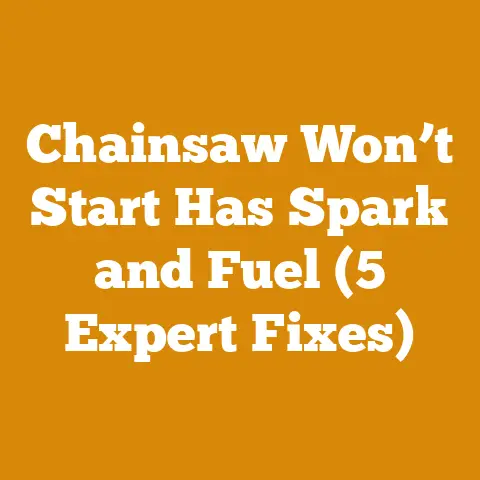Trailer for Firewood: Choosing Between Dump vs Utility (5 Pro Tips)
The quest for firewood is as old as civilization itself, a timeless pursuit that connects us to our ancestors. Whether you’re a seasoned homesteader, a weekend warrior prepping for winter, or a small-scale firewood business owner, hauling firewood efficiently is crucial. The choice between a dump trailer and a utility trailer is a pivotal one, influencing not only your workload but also your budget. I’ve spent years wrestling with logs, splitting wood, and optimizing my own firewood operation, and I’ve learned a thing or two about making the right equipment choices. Let’s dive deep into the world of firewood trailers, exploring the nuances of dump vs. utility, and equipping you with the knowledge to make an informed decision, along with some money-saving tips I’ve picked up along the way.
Trailer for Firewood: Choosing Between Dump vs Utility (5 Pro Tips)
The heart of this decision lies in understanding your specific needs, budget, and the type of firewood operation you’re running. Are you moving large volumes of green wood? Or are you primarily dealing with seasoned, ready-to-burn firewood? Do you need the convenience of effortless unloading? These are the questions we’ll tackle.
1. Understanding Your Firewood Hauling Needs
Before even thinking about hitches and axles, let’s get crystal clear on what you’ll be hauling. This is where the rubber meets the road, and honestly, where many folks make their biggest mistakes.
-
Volume and Weight: How much firewood are you planning to move at a time? A standard cord of firewood weighs roughly 2,000-4,000 pounds, depending on the wood species and moisture content. Green wood, fresh from the tree, will be significantly heavier. This is a critical factor in determining the required trailer capacity. A half-cord of green oak can easily max out a light-duty utility trailer.
- Insight: I remember one year, I drastically underestimated the weight of green ash I was hauling. My poor little utility trailer was groaning under the strain, and I ended up making twice as many trips as I should have. Lesson learned: always overestimate, especially with green wood.
-
Wood Species: Different wood species have vastly different densities. Oak, hickory, and maple are dense hardwoods, while pine, poplar, and cedar are lighter softwoods. This impacts the weight per cord and, consequently, the trailer’s load capacity.
- Data Point: According to the U.S. Forest Service, the air-dried weight of a cord of oak can be 4,500 lbs, while a cord of pine might only weigh 2,500 lbs.
-
Terrain and Accessibility: Where will you be hauling firewood? Smooth paved roads? Rough, muddy trails? A dump trailer with higher ground clearance might be essential for navigating challenging terrain. Consider the turning radius needed in your typical drop-off locations. Will you be able to maneuver a longer trailer in tight spaces?
- Personal Experience: I once tried to haul firewood down a narrow, rutted logging road with a low-slung utility trailer. It was a disaster. The trailer bottomed out repeatedly, and I spent more time digging it out than hauling wood. A dump trailer with its higher clearance would have been a lifesaver.
-
Loading and Unloading Methods: How will you load and unload the firewood? By hand? With a tractor or skid steer? A dump trailer simplifies unloading, especially for large volumes. A utility trailer requires manual unloading, which can be back-breaking work.
-
Tip: If you’re loading with a machine, make sure the trailer’s side rails are strong enough to withstand the impact. I’ve seen flimsy trailer sides get bent and damaged by careless loader operators.
2. Dump Trailer: The Heavy-Duty Workhorse
Dump trailers are the powerhouses of the firewood hauling world. Their primary advantage is their ability to unload quickly and easily, saving you significant time and labor.
-
Pros:
- Effortless Unloading: Hydraulic lift systems allow you to dump the entire load in minutes, eliminating the need for manual labor. This is a huge time-saver, especially when dealing with large volumes.
- High Load Capacity: Dump trailers are typically built with heavier axles and frames, allowing them to carry significantly more weight than utility trailers.
- Durability: Designed for tough jobs, dump trailers are built to withstand heavy use and abuse.
- Versatility: Beyond firewood, dump trailers can be used for hauling gravel, dirt, mulch, and other materials.
-
Cons:
- Higher Cost: Dump trailers are significantly more expensive than utility trailers.
- Heavier and Less Maneuverable: Their larger size and weight can make them more difficult to maneuver, especially in tight spaces.
- Maintenance: Hydraulic systems require regular maintenance.
- Permits and Regulations: Depending on your location and the trailer’s weight rating, you may need special permits or licensing to operate a dump trailer.
-
Cost Breakdown:
-
Purchase Price: New dump trailers typically range from $5,000 to $20,000+, depending on size, capacity, and features. Used dump trailers can be found for less, but be sure to inspect them thoroughly for signs of wear and tear.
- Data Point: According to a recent survey of trailer dealerships, the average price of a new 14-foot dump trailer with a 10,000-pound GVWR is around $8,500.
-
Maintenance Costs: Expect to spend $200-$500 per year on routine maintenance, such as hydraulic fluid changes, brake inspections, and tire replacements.
-
Fuel Costs: Hauling a heavy dump trailer will increase your fuel consumption. Estimate an additional 10-20% fuel cost compared to hauling a lighter utility trailer.
-
Insurance Costs: Insurance rates for dump trailers are typically higher than for utility trailers due to their higher value and potential for damage.
-
Example Scenario: Let’s say you purchase a $10,000 dump trailer and use it to haul 50 cords of firewood per year. Over a five-year period, your total costs might look like this:
- Trailer Purchase: $10,000
- Maintenance: $1,500 (over 5 years)
- Fuel Increase: $500 (per year, assuming $10 extra per cord) = $2,500
- Insurance Increase: $200 (per year) = $1,000
- Total Cost: $15,000
- Cost per Cord: $15,000 / (50 cords/year * 5 years) = $60 per cord
-
-
Dump Trailer Sizes to Consider:
- 10-foot Dump Trailer: Ideal for smaller operations or homeowners hauling firewood for personal use.
- 12-foot Dump Trailer: A good compromise between capacity and maneuverability.
- 14-foot Dump Trailer: Suitable for larger operations hauling significant volumes of firewood.
3. Utility Trailer: The Versatile All-Rounder
Utility trailers are the Swiss Army knives of the trailer world. They’re more affordable and versatile than dump trailers, making them a popular choice for a wide range of tasks.
-
Pros:
- Lower Cost: Utility trailers are significantly cheaper than dump trailers.
- Lightweight and Maneuverable: Their smaller size and lighter weight make them easier to maneuver, especially in tight spaces.
- Versatility: Utility trailers can be used for hauling a variety of materials, including firewood, lawn equipment, furniture, and more.
-
Cons:
- Manual Unloading: Requires manual unloading, which can be time-consuming and physically demanding.
- Lower Load Capacity: Typically have a lower load capacity than dump trailers.
- Less Durable: Not as robustly built as dump trailers, making them more susceptible to damage from heavy use.
-
Cost Breakdown:
-
Purchase Price: New utility trailers typically range from $1,000 to $5,000, depending on size, capacity, and features. Used utility trailers can be found for even less.
- Data Point: A survey of trailer dealerships indicates that the average price of a new 6×12 utility trailer with a 3,500-pound GVWR is around $2,500.
-
Maintenance Costs: Maintenance costs are generally lower than for dump trailers, but you’ll still need to factor in tire replacements, brake repairs, and general upkeep.
-
Fuel Costs: Hauling a lighter utility trailer will have a minimal impact on your fuel consumption.
-
Insurance Costs: Insurance rates for utility trailers are typically lower than for dump trailers.
-
Example Scenario: Let’s say you purchase a $2,500 utility trailer and use it to haul 50 cords of firewood per year. Over a five-year period, your total costs might look like this:
- Trailer Purchase: $2,500
- Maintenance: $500 (over 5 years)
- Fuel Increase: Negligible
- Insurance Increase: Negligible
- Total Cost: $3,000
- Cost per Cord: $3,000 / (50 cords/year * 5 years) = $12 per cord
-
-
Utility Trailer Sizes to Consider:
- 5×8 Utility Trailer: Suitable for small-scale firewood hauling or homeowners with limited storage space.
- 6×12 Utility Trailer: A popular choice for general-purpose hauling, including firewood.
- 7×14 Utility Trailer: Provides ample space for hauling larger volumes of firewood.
4. The Hidden Costs: Beyond the Sticker Price
Don’t just focus on the initial purchase price of the trailer. There are several hidden costs that can significantly impact your overall budget.
- Registration and Licensing Fees: These fees vary depending on your location and the trailer’s weight rating. Be sure to factor them into your budget.
- Hitch and Wiring: If you don’t already have a suitable hitch and wiring harness on your vehicle, you’ll need to purchase and install them. This can cost several hundred dollars.
- Tire Replacements: Trailer tires wear out over time, especially when hauling heavy loads. Factor in the cost of replacing tires every few years.
- Brake Repairs: Trailer brakes require regular maintenance and occasional repairs.
- Storage: Do you have a safe and secure place to store your trailer when it’s not in use? If not, you may need to pay for storage space.
- Labor Costs (If Applicable): If you’re hiring someone to load and unload the firewood, factor in their wages.
5. Optimizing Your Firewood Operation for Cost Efficiency
Regardless of whether you choose a dump trailer or a utility trailer, there are several ways to optimize your firewood operation for cost efficiency.
- Buy Wood in Bulk: Purchasing logs in bulk from a local logger or timber company can often save you money compared to buying pre-cut firewood.
-
Season Firewood Properly: Properly seasoned firewood burns more efficiently and produces more heat, reducing the amount of wood you need to burn. Aim for a moisture content of 20% or less.
- Formula: You can estimate drying time using the following formula: Drying Time (months) = (Initial Moisture Content – Target Moisture Content) / Drying Rate. The drying rate varies depending on climate and wood species, but a general rule of thumb is 1-2% per month.
-
Invest in Quality Tools: A good chainsaw, splitting axe, and firewood processor can significantly increase your efficiency and reduce your labor costs.
- Personal Anecdote: I used to struggle with a cheap, underpowered chainsaw. It took me forever to cut through logs, and I was constantly fighting with it. Investing in a high-quality chainsaw was a game-changer. It made the job much easier and faster, and it’s paid for itself many times over in time saved.
-
Negotiate Prices: Don’t be afraid to negotiate prices with suppliers, vendors, and customers.
- Track Your Expenses: Keep track of all your expenses, including fuel, maintenance, and labor. This will help you identify areas where you can cut costs.
-
Consider a Firewood Processor: If you’re processing large volumes of firewood, a firewood processor can significantly increase your efficiency and reduce your labor costs. These machines cut and split logs in one automated process.
- Cost Analysis: Firewood processors can range in price from $5,000 to $50,000+, depending on their capacity and features. However, they can significantly reduce your labor costs and increase your production volume. Before investing, carefully analyze your production needs and determine if the cost of a processor is justified.
-
Explore Local Resources: Check with your local extension office or forestry department for information on firewood regulations, best practices, and potential grant programs.
Case Study: Comparing Dump vs. Utility for a Small Firewood Business
Let’s consider a hypothetical small firewood business that sells 100 cords of firewood per year. We’ll compare the costs of using a dump trailer versus a utility trailer.
Scenario:
- Firewood Sold: 100 cords per year
- Time Horizon: 5 years
Dump Trailer Option:
- Trailer Purchase Price: $10,000
- Annual Maintenance: $300
- Annual Fuel Increase: $500
- Annual Insurance Increase: $200
- Labor Savings: Assume the dump trailer saves 2 hours of labor per cord, at a labor rate of $20/hour = $4,000 savings per year
Utility Trailer Option:
- Trailer Purchase Price: $2,500
- Annual Maintenance: $100
- Annual Fuel Increase: Negligible
- Annual Insurance Increase: Negligible
- Labor Costs: $4,000 per year (based on 2 hours of manual unloading per cord)
Cost Comparison Over 5 Years:
| Cost Item | Dump Trailer | Utility Trailer |
|---|---|---|
| Trailer Purchase | $10,000 | $2,500 |
| Maintenance | $1,500 | $500 |
| Fuel Increase | $2,500 | $0 |
| Insurance Increase | $1,000 | $0 |
| Labor Savings/Cost | -$20,000 | $20,000 |
| Total Cost | -$5,000 | $23,000 |
Analysis:
In this scenario, the dump trailer is actually more cost-effective over a five-year period due to the significant labor savings. The initial higher cost of the dump trailer is offset by the reduced labor costs associated with manual unloading. This highlights the importance of considering all costs and benefits when making your decision.
Important Considerations:
- This is just a hypothetical example, and your actual costs and savings may vary.
- The labor savings will depend on your specific operation and the efficiency of your workers.
- The fuel increase will depend on your vehicle, the weight of the trailer, and the distance you’re hauling.
The Bottom Line: Choosing the Right Trailer for You
There’s no one-size-fits-all answer to the dump trailer vs. utility trailer debate. The best choice for you will depend on your specific needs, budget, and the scale of your firewood operation.
-
Choose a Dump Trailer if:
- You’re hauling large volumes of firewood.
- You want to minimize manual labor.
- You have the budget for a more expensive trailer.
- You need to navigate challenging terrain.
-
Choose a Utility Trailer if:
- You’re hauling smaller volumes of firewood.
- You’re on a tight budget.
- You prioritize maneuverability.
- You need a versatile trailer for other tasks.
Ultimately, the decision is yours. Carefully consider your needs, weigh the pros and cons of each type of trailer, and choose the option that best fits your budget and your goals.
As a parting thought, remember that the most important tool in your firewood arsenal is not a trailer, but a well-thought-out plan. By understanding your needs, budgeting carefully, and optimizing your operation, you can ensure that your firewood business is both profitable and sustainable for years to come. And, of course, always prioritize safety when working with heavy equipment and sharp tools. Happy hauling!





